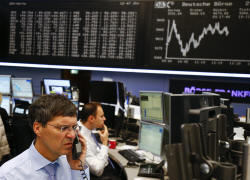Shares shudder at potential Ukraine conflict
 Send a link to a friend
Send a link to a friend
 [January 24, 2022] By
Tom Wilson and Wayne Cole [January 24, 2022] By
Tom Wilson and Wayne Cole
LONDON/SYDNEY (Reuters) - Shares across the
world fell on Monday as the prospect of a Russian attack on Ukraine
quashed demand for riskier assets, bolstering the dollar, buoying oil
and bruising bitcoin.
The U.S. State Department said on Sunday it was ordering diplomats'
family members to leave Ukraine in one of the clearest signs yet that
American officials are bracing for an aggressive Russian move in the
region.
U.S. President Joe Biden weighed options for boosting United States'
military assets in the region to counter a buildup of Russian troops,
with the New York Times reporting that Biden was looking at sending
1,000 to 5,000 troops to eastern Europe.
The Euro STOXX 600 fell 1.3% to its lowest since Dec. 20, with indexes
in London, Paris and Frankfurt down between 0.8% and 1.5%.
Tech stocks led losses, falling 2.3% to their lowest since October after
Wall Street was pummelled last week by prospects of rising interest
rates.
Analysts noted a reluctance among investors to pile back into equities
rarely seen in the post-2008 era of ultra-low interest rates and central
bank-boosted liquidity.

"Ukraine at the moment is really front of mind," said Michael Hewson,
chief market analyst at CMC Markets. "Over the last 12 years,
buy-the-dip is the mentality for investors generally. This the first
time in the last 12 years, I've felt, that's not the default position to
be in."
MSCI's broadest index of Asia-Pacific shares outside Japan fell 0.7% and
Japan's Nikkei eased 0.1%.
Still, Wall Street looked set to rebounded somewhat after last week's
drubbing, with the S&P 500 futures and Nasdaq futures both up about
0.3%.
The MSCI world equity index, which tracks shares in 50 countries, fell
0.3%.
Oil prices rose again, having climbed for five weeks in a row to a
seven-year peak on expectations demand will stay strong and supplies
limited. [O/R]
Bitcoin fell as much as 5% in Monday trade to $34,551, not far from a
six-month low of $34,000 hit on Saturday. The cryptocurrency has lost
almost half of its value since hitting an all-time high of $69,000 in
November.
FED NERVES
Nerves over the Fed's meeting on Wednesday added to the mix. The U.S.
central bank is expected to confirm it will soon start draining the
massive pool of liquidity that has supercharged growth stocks in recent
years.
[to top of second column] |

Traders work at their desks in front of the German share price
index, DAX board, at the stock exchange in Frankfurt, Germany,
January 21, 2016. REUTERS/Kai Pfaffenbach

Anxious markets are now even pricing in a small chance the Fed hikes rates this
week, though the overwhelming expectation is for a first move to 0.25% in March
and three more to 1.0% by year end.
"With inflation eye-wateringly high, the Fed is on course to steadily remove the
ultra-accommodative monetary policy that has been a key prop to stock prices for
over a decade now," said Oliver Allen, a market economist at Capital Economics.
The prospect of higher borrowing costs and more attractive bond yields has taken
a toll on U.S. tech stocks with their lofty valuations, leaving the Nasdaq down
12% so far this year and the S&P 500 nearly 8%.
Such was the scale of the losses that Treasuries actually rallied late last week
on speculation the bonfire of market wealth might scare the Fed into being less
hawkish.
While Treasuries did bounce late last week, 10-year yields are still up 22 basis
points on the month so far at 1.77% and not far from levels last seen in early
2020.
That rise has generally supported the U.S. dollar, which added 0.5% on a basket
of currencies last week and last stood up 0.1% at 85.647.
"We suspect the dollar may derive broader support," analysts at MUFG wrote.
Wednesday's meeting "is likely to see continued hawkishness with the Fed being
more concerned over inflation risks and showing determination to reverse
monetary easing more quickly."
Brent added 83 cents to $88.72 a barrel, while U.S. crude rose 77 cents to
$85.91.

Analysts cited worries about supply disruption as tensions rose Eastern Europe,
while OPEC and its allies continued to struggle to raise output.[O/R]
(Reporting by Tom Wilson in London and Wayne Cole in Sydney; Editing by Sam
Holmes, Edwina Gibbs and Tomasz Janowski)
[© 2022 Thomson Reuters. All rights
reserved.]This material may not be published,
broadcast, rewritten or redistributed.
Thompson Reuters is solely responsible for this content. |